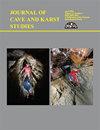Seasonal context of Bristly Cave Crayfish Cambarus setosus habitat use and life history
IF 0.5
4区 地球科学
Q4 GEOSCIENCES, MULTIDISCIPLINARY
引用次数: 1
Abstract
Cave crayfishes are important members of groundwater communities, but many cave crayfishes are threatened or endangered. Unfortunately, we lack basic life history and ecological data that are needed for developing conservation plans for most cave crayfishes, especially the role of seasonal and annual fluctuations in structuring populations. Therefore, we determined the seasonal life history and habitat use of Cambarus setosus in Smallin Civil War Cave, Christian County, Missouri, United States. We conducted visual crayfish surveys over a 400 m section of the cave from 2006 to 2019. We used multinomial logit, multiple linear regression, and logistic regression models to estimate crayfish substrate, water depth, and water velocity use, respectively. All models included sex, carapace length, season, distance into the cave, and interactions between all variables and sex as predictor terms. We also used t-tests to assess morphometric differences between male and female crayfish. Six mark-recapture events (2010 to 2019) were used to estimate population sizes using a nil-recapture model. We attempted to age eight individuals using gastric mill bands, but annual bands were not discernable. We found reproductively active males during all seasons. We captured one ovigerous female during the spring, though ovigerous females were observed during show cave tours during spring, summer, and autumn. Male C. setosus were more likely to use homogenous and heterogeneous rock substrates and shallower and calmer water when compared to females; however, these relationships varied based on distance into the cave and season. Females sampled were significantly larger than males, and males regenerated chelae more often. Minimum population size estimates ranged from 9 to 159 individuals and indicated the population was relatively stable. Our data provide both a baseline population estimate for comparison with future studies and valuable trait information that is often lacking but useful for developing conservation efforts.石窟小龙虾栖息地利用与生活史的季节背景
洞穴小龙虾是地下水群落的重要成员,但许多洞穴小龙虾受到威胁或濒临灭绝。不幸的是,我们缺乏为大多数洞穴小龙虾制定保护计划所需的基本生活史和生态数据,特别是季节性和年度波动在结构种群中的作用。因此,我们在美国密苏里州克里斯蒂安县的斯莫林内战洞穴(Smallin Civil War Cave)测定了Cambarus setosus的季节性生活史和栖息地利用。从2006年到2019年,我们对洞穴400米长的区域进行了视觉小龙虾调查。我们分别使用多项logit、多元线性回归和逻辑回归模型来估计小龙虾的基质、水深和水速度的利用。所有的模型都包括性别、甲壳长度、季节、进入洞穴的距离,以及所有变量和性别之间的相互作用。我们还使用t检验来评估雄性和雌性小龙虾之间的形态计量差异。6个标记-再捕获事件(2010年至2019年)用于使用零再捕获模型估计种群规模。我们尝试使用胃磨带对8个个体进行年龄测定,但年际带无法识别。我们发现一年四季都有繁殖活跃的雄性。我们在春季捕获了一只羽绒服的雌性,尽管在春季,夏季和秋季的洞穴参观中观察到了羽绒服的雌性。与雌性相比,雄性固固螺更倾向于使用均质和非均质岩石基质和更浅、更平静的水;然而,这些关系根据进入洞穴的距离和季节而变化。雌虫明显大于雄虫,且雄虫再生螯体的频率更高。最小种群规模估计在9 ~ 159只之间,表明种群相对稳定。我们的数据提供了与未来研究比较的基线种群估计和有价值的性状信息,这些信息通常缺乏,但对发展保护工作有用。
本文章由计算机程序翻译,如有差异,请以英文原文为准。
求助全文
约1分钟内获得全文
求助全文
来源期刊

Journal of Cave and Karst Studies
地学-地球科学综合
CiteScore
1.90
自引率
0.00%
发文量
6
审稿时长
>12 weeks
期刊介绍:
The Journal of Cave and Karst Studies is a multidisciplinary journal devoted to cave and karst research. The Journal is seeking original, unpublished manuscripts concerning the scientific study of caves or other karst features. Authors do not need to be members of the National Speleological Society, but preference is given to manuscripts of importance to North American speleology.
 求助内容:
求助内容: 应助结果提醒方式:
应助结果提醒方式:


